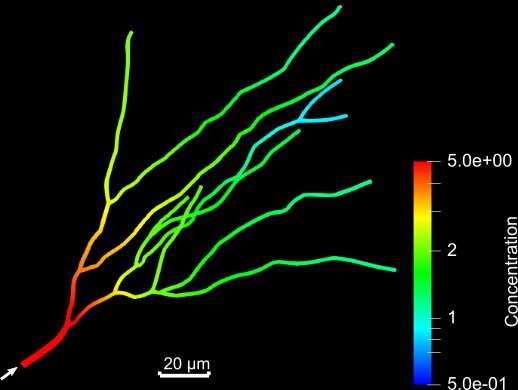Using deep learning to research material transport in the brain

The brain is the most complex organ in the human body, controlling everything from senses to behaviors. Like any part of the body, it is subject to various errors that affect cognitive and physical functions, some of which include Huntington's disease, Parkinson's disease, and Alzheimer's disease. Unfortunately, little is known about treating or curing these degenerative disorders, leading to care mostly involving management of symptoms.
However, the cause of these diseases and others, as well as a potential for preventative methods or curative treatments, may be within our grasp.
Jessica Zhang and Angran Li have researched the transport of essential materials throughout the neurite networks—portions of the neurons that move nerve impulses in and out of the neuron. The findings were published in the journal Scientific Reports.
"It is a very new technology, using a multi-physics system to study the neuron material transport," said Zhang, professor of mechanical engineering at Carnegie Mellon University. "It is critical to study neuron degenerative disease. In this research, we focus on using machine learning to quickly predict the concentration of the simulation's results. That has a lot of potential impact in understanding the material transport in complex neuron geometry. This will be very useful to help us understand how diseases develop."
Their research involves using a Graph Neural Network (GNN)-based deep learning model to discover the isogeometric analysis (IGA)-based material transport simulation of axon branches, which release the transport materials. These methods assume that material concentration distribution can be predicted locally and assembled based upon graphical representation, allowing for the concentration distribution to be restored.
Amir Barati Farimani, assistant professor of mechanical engineering, provided help in selecting proper deep learning models for this study.
Where most literature has only examined one-dimensional problems, their research is multifaceted, taking a complex three-dimensional approach. "Deep learning can make the whole procedure very efficient, with high accuracy," said Zhang. "What we want to emphasize is that this can help us understand and pursue more investigation of neuron degenerative diseases."
Zhang also highlighted the importance of the technology, which enabled them to complete an accurate, robust, efficient study.
Angran Li is a Ph.D. student in mechanical engineering at Carnegie Mellon.
More information: Li, A., Barati Farimani, A. & Zhang, Y.J. Deep learning of material transport in complex neurite networks. Scientific Reports (2021). DOI: 10.1038/s41598-021-90724-3



















